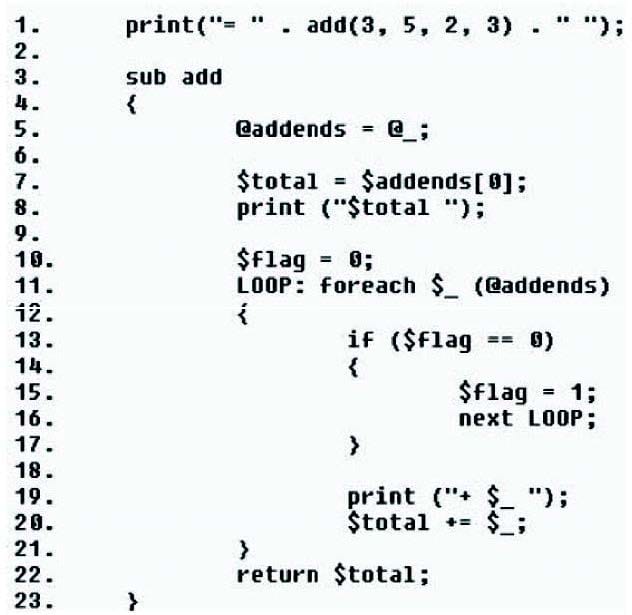1D0-437 Online Practice Questions and Answers
Assuming $a = 2, which of the following evaluates as false?
A. "False"
B. $a
C. $a < 0
D. 1
Consider the following program code:
@stack = (10, 10..25);
push(@stack, yellow);
shift(@stack);
push(@stack, white);
print shift(@stack);
What is the result of executing this program code?
A. The code will fail at line 3 because shift requires two arguments.
B. The code will output the following: 11
C. The code will output the following: 10
D. The code will output the following: white
Consider the following code:
$_ = "New York";
@array2 = split(//);
What is the value of $array2[0] after the code is executed?
A. ""
B. "N e w"
C. "NewYork"
D. "N"
Which of the following is a valid subroutine name?
A. _funct7
B. get-pass
C. #sub1
D. @passwd
Yngve wants to define a character class that includes any alphanumeric word characters.

Which one of the following choices is best suited for this requirement?
A. /[a-zA-Z_0-9]/;
B. /^w/;
C. /[^a-zA-Z_0-9]/;
D. /[^0-Z$]/;
Which keyword indicates an object reference rather than a variable reference?
A. return
B. bless
C. package
D. object
Running your Perl scripts with a w switch will perform which task?
A. Print all commands to the screen
B. Print warnings to the error.log file
C. Print check points in loops
D. Print warnings to the screen
Consider the following program code:
1.$x = 100;
2.$y = "-25";
3.$sum = $x + $y;
4. 5.print $sum;
What is the result of executing this program code?
A. The code will output the following: 100-25
B. The code will output the following: 75
C. The code will fail at line 3 because $y contains string data.
D. The code will output the following: 125
Consider the following lines of code:
$_ = "This is a test";
s/^([^ ]*)\s*([^ ]*)/$2 $1/;
print;
What is the output of these lines of code?
A. h Tis a test
B. is This a test
C. i Thiss a test
D. his T is a test
Which statement is the most accurate?
A. The push function adds elements to the beginning of an array.
B. The push function removes the first element in an array.
C. The pop function removes the first element in an array.
D. The pop function removes the last element in an array.
Consider the following lines of code:
sub mySub { (
$arg, @args) = @_;
foreach $val (@args) {
$returnVal .= "$arg, $val\n";
}
$returnVal . "" . @args;
}
print andmySub(1, "a value", "another value", "a parameter", "another parameter"); What is the output of
these lines of code?
A. 1, a value 1, another value 1, a parameter 1, another parameter 4
B. 1, a value 1, another value 1, a parameter 1, another parameter a valueanother valuea parameteranother parameter
C. 1, a value, another value, a parameter, another parameter a value another value a parameter another parameter
D. 1, a value, another value, a parameter, another parameter 4
Consider the following code:
%hashA = ("alpha", "beta", "gamma", "alpha");
%hashA = reverse(%hashA);
print $hashA{"alpha"};
What is the result of executing this code?
A. The code outputs the following: alpha
B. The code outputs the following: beta
C. The code outputs the following: gamma
D. The code fails at line 3.
Consider the following program code:
@array = ("ALPHA", "beta", "GaMmA");
sort(@array);
print("@array");
What is the output of this code?
A. beta GaMmA ALPHA
B. ALPHA GaMmA beta
C. ALPHA beta GaMmA
D. beta ALPHA GaMmA
Which one of the following statements opens a file for appending?
A. open(PASSWD, ">/etc/passwd");
B. open(PASSWD ">/etc/passwd");
C. open(PASSWD, ">>/etc/passwd");
D. open(PASSWD "+>/etc/passwd");
Consider the following code:
%chars = ("a", "100", "b", "90", "c", "80");
Which one of the following choices will reverse the key/value pairing of the code?
A. reverse(%chars);
B. %chars = reverse(%chars);
C. reverse(%chars) = %chars;
D. invert(%chars);
